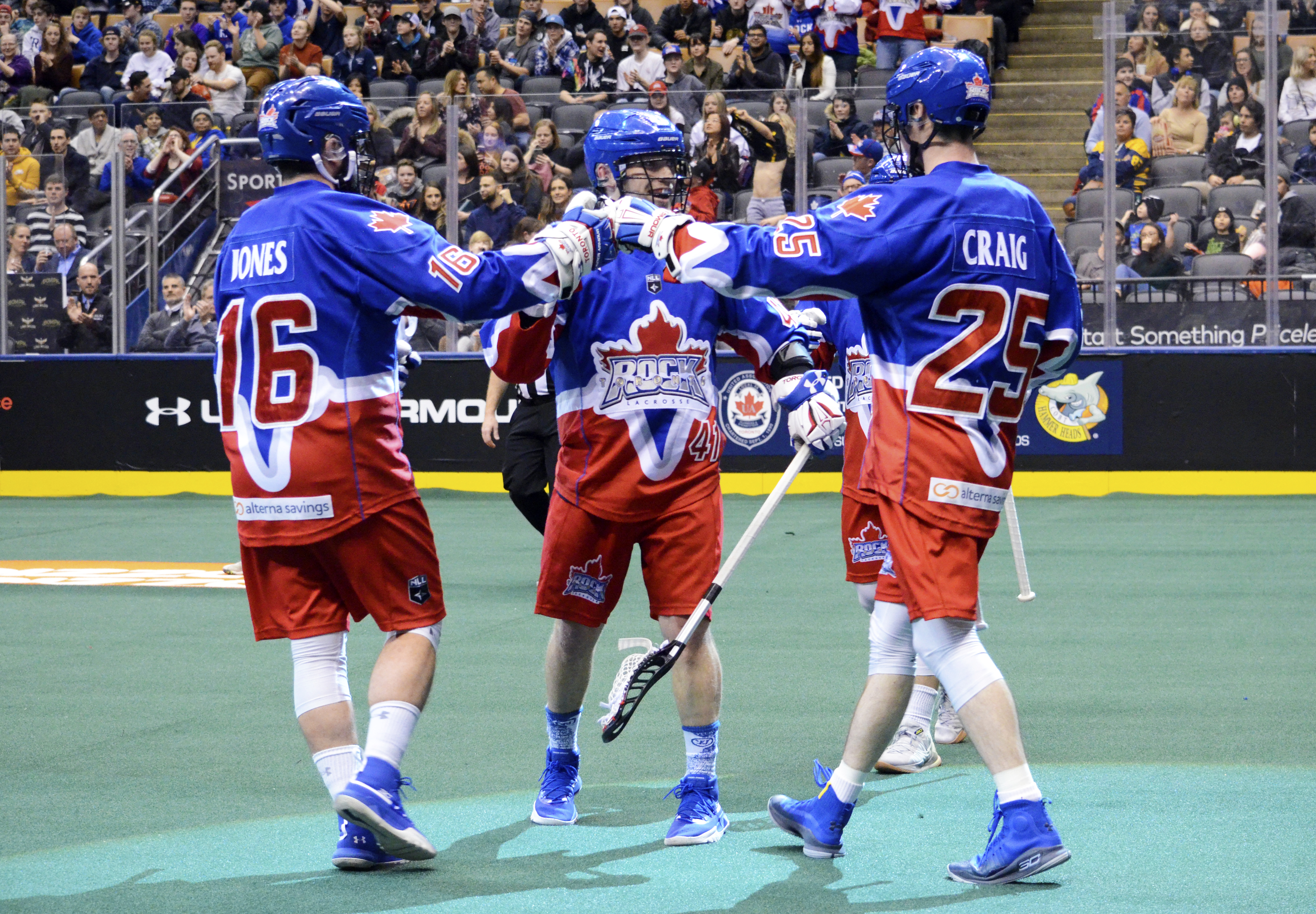
What a week in the NLL. First the news of the Saskatchewan Rush being sold came (but staying in Saskatoon, for now at least), and then the Toronto Rock announced they’re moving to Hamilton.
The Sask news caught us by surprise, but the Rock news – well, with apologies to our readers, we’ve known since March. Out of respect for the people who weren’t supposed to leak the news, we couldn’t tell you. But, it’s given us a lot of time to think about the possible ramifications of the move, both the positive and negative aspects of the deal.
Everyone else has written about the details – starting this December, five-year lease at FirstOntario Centre, there will be no team name change – so read on for some analysis of why this is – or isn’t – a good move for the NLL franchise.
The Business of it All
I can’t find the tweet now, but someone posted the approximate costs for renting Scotiabank Arena – $45,000 per game – vs. FirstOntario Centre – $9000 per game. If that’s accurate, that in itself is a reason to move. Maple Leaf Sports and Entertainment, owners of Scotiabank Arena and its major tenants (NHL’s Maple Leafs, NBA’s Raptors) could charge outsiders exorbitant prices and not blink an eye.
From a 2016 Toronto Star article: As he continues to lose money on the team, Dawick is not in a selling mood. “It’s not about money,” he says. “I’m not holding out for a number. I want to own this team. I love this team. It’s not for sale.”
It’s been a long time since the Rock have made money, but owner Jamie Dawick has never been in it for the that. But maybe there came a point where the losses became just a little too great, especially with a cancelled season. Moving to an arena where the costs are significantly cheaper is just good business sense.
How the Fans Win
The Rock have promised lower ticket prices, especially for their season ticket holders. STHs can also join the Rock City Builder’s Club (fantastic name, by the way) and be one of the first 5000 fans to make the move with the team. In addition to three years of locked-in pricing, they will receive a jersey for every seat purchased.
Lower rent for the team also means lower parking fees and lower concession stand prices for the fans. We sure won’t miss the $18 wraps or $7 cardboard pizza slices that Scotiabank Arena offered.
The biggest win for the fans is guaranteed Saturday night home games. With only the OHL’s Hamilton Bulldogs to compete with for arena scheduling, fans will be able to relax and take their time on game days, instead of worrying about leaving work early to travel to downtown Toronto.
That said, OHL hockey is big business in Ontario, and I won’t be surprised to see some date competition arise in the future when playoff time comes.
The Arena
Moving to FirstOntario Centre is absolutely a downgrade. The former Copps Coliseum was built in 1985 and it shows in the colours and design. Scotiabank Arena may be 20 years old now, but it’s still a premiere sports destination in Canada’s biggest city. Going to Scotiabank Arena for a concert or a game is still a big deal to a lot of people, and playing there is the dream of most young athletes.
Having spoken to one of the players, however, they’re excited to be able to have their own dressing room, a dedicated space that won’t be taken over by a visiting NHL or NBA team. They can leave their things there, decorate, and make it feel like home, which can only be a bonus to their on-floor performance.

The East is Losing Out
At Tuesday’s press conference, Dawick addressed questions about the team’s fans located in the eastern GTA and eastern Ontario:
“I think you could make the argument that people from Six Nations have a tough time getting to a game in Toronto. Unfortunately a lot of fans don’t come from downtown Toronto, it’s the surrounding communities. We’re very conscious of our fans from east of Toronto and outside of the city. Having access to Saturday night home games gives us the opportunity to become more accessible to even more people. Fans will be able to travel in and out of Hamilton with ease and enjoy the city both before and after the game. We will be able to provide a more affordable full game day experience.”
He also said, “We knew there were going to be some fans that weren’t going to be thrilled with [the move] especially those east of the city. I think most of the fans understand why we’re doing this. The support is there for the team. I’d love them all to come along with us. This is everyone’s team. You have to make business decisions and here we are.”
Sure, you could probably get from Whitby to Hamilton in the same time you could get from Whitby to downtown Toronto, since you can go around the provincial capital on the highway, but if you’re taking transit (to be eco conscious or because you don’t have a car or because your car can’t afford gas or your kid gets carsick – there are a myriad of reasons) your commute just got exponentially longer.
The Go Transit system can get you almost anywhere from Peterborough to Niagara Falls, but schedules are tricky and departures are few and far between from outlying areas. A lot of people from outside the eastern GTA drive to Oshawa to catch the train, and some take a bus in from places like Peterborough, Brooklin, Beaverton or Barrie. From there, it’s one hour into Toronto, and one hour out of it to get to Aldershot. Then you have to catch a bus into Hamilton. Though Hamilton has a Go Train Station, the train is rarely used. Getting back is even more of an issue, as some buses to outlying areas stop running before the train would get you to your transfer point.
Saturday games help the situation somewhat, and are a necessity to help out-of-town fans access the games. Instead of being a night out, going to a Rock game is now an entire day’s commitment for some fans.
Dawick stressed that the Rock is everyone’s team, but from where we sit in the east, it doesn’t quite feel like it.
Toronto vs. Hamilton vs. Buffalo
There are a few things to unpack here. Let’s start with a visit to Toronto over Hamilton. Toronto is a hub with a huge population and innumerable touristy things to do. It’s a common meeting spot for friends and family coming in from either side of the GTA. Going to a Rock game was part of a larger weekend getaway for some. The experience won’t be quite the same in Hamilton, a smaller city with fewer transit options, as mentioned above. The allure of a weekend away just doesn’t hit the same.
Next is the rivalry between Toronto and Hamilton. Hamiltonians hate anything from Toronto, and Torontonians hate anything that isn’t from Toronto. Hamilton is a blue collar town that depends on the steel industry to survive. Toronto is the affluent, white collar big brother. Don’t ever put an Argos fan in a room with a TiCats fan. There will be bloodshed.
We know how passionate people are about sports, but don’t boycott a pro lacrosse team just because of its name – you’re still in the Greater Toronto and Hamilton Area.
Said Dawick, “You’ll see us visible in Hamilton, but we represent the GTHA. When you’re traveling and you have a brand, no disrespect to the people in Hamilton, a lot of people look at you and think you could be from Bermuda.”
This move may also impact the Buffalo Bandits, especially those in St. Catharines and Niagara, for whom Buffalo is only half an hour away. But switching allegiances in sports is a tough sell, so I doubt the Rock will take away many of the Banditland faithful. Crossing the border means you can stop at Target or Olive Garden on your way to the game. I’d be interested to know how many of the Bandits’ season ticket holders are Canadian.
The Lack of Name Change
For people outside of Ontario, their most common knowledge of the province is likely Toronto so still associating the team with Toronto makes sense. The New England Black Wolves represented that whole area, and they played out in the middle of nowhere in Connecticut. That’s why, as mentioned above, the Toronto Rock brand needs to stay intact.
“The Rock are a pillar franchise,” Dawick said. “Nothing’s really changed. Now, when I pull out of headquarters in Oakville, I’m heading 30 km to the west instead of east. We’ve always represented the GTA. The only thing that changed is the location.”
That headquarters in Oakville is called the Toronto Rock Athletic Centre and its reputation in the lacrosse community and larger sports community mean a lot. Changing the whole brand would be a huge financial cost and potentially detrimental to the reputation of that side of Dawick’s business. Also, the HRAC just doesn’t roll off the tongue like the TRAC.
Conclusion
Go to a game if you can. Go to all the games if you can. Let’s count ourselves lucky that the Rock are still close enough for us to cheer for in person. When it’s safe, carpool with a bunch of friends to make the drive easier.
The move to Hamilton isn’t going to kill the Toronto Rock, as several have said on replies to team and league social media. In fact, the team will likely thrive in Hamilton and draw many more fans from the western GTHA. But people in the eastern part of the province will lose out, and that’s going to be a bitter pill to swallow for those fans.
Could this open up the field for an NLL team in Ottawa? We hope so. There have been rumblings of an ownership group working for several years to bring the NLL back to the nation’s capital, and it would give the fans in the eastern part of Ontario another option for traveling to a pro lacrosse game. Ottawa itself is still going to be a jaunt for most, but its far enough away from Hamilton to be a completely separate entity while still providing a great rivalry opportunity for Ontario lacrosse fans.
— With files from Matt Caruk

